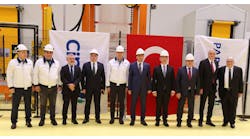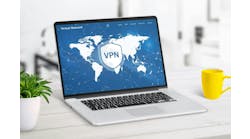ABB’s Morten Wierod (from left) moderated a panel, including ABB’s Peter Terwiesch, Krones’ Michael Wiebe, BP’s Richard Mortimer and ABB Guido Jouret, who discussed the future of industry at ABB Customer World in Houston.
When asked what affect digitalization will have on industry, a panel of seasoned experts offered differing yet complementary perspectives on what aspects of the future the increasingly rapid adoption of digital technologies will most transform. The panel addressed a luncheon gathering of attendees at this week’s ABB Customer World in Houston.
For Michael Wiebe, chief operations officer at packaging and processing equipment maker Krones, the biggest driver of artificial intelligence (AI) and machine learning adoption is total cost of ownership (TCO). “Machines and lines are becoming faster, and overall complexity is increasing,” he said. “Our connected lines today include sensors, a cloud connection and a dashboard—and the more data that is collected, the better our watchdog becomes. These connected line tools are more proactive, and that keeps the TCO in check.”
At oil & gas supermajor BP, the primary aim is to use the digital information to supply more energy while maintaining or reducing carbon levels. “We’re aiming to hold our own greenhouse gases emissions flat,” explained Richard Mortimer, vice president of engineering, global products, BP. “ABB is playing a big role as a partner with us for improving system performance, allowing us to produce more energy without increasing emissions,” Mortimer said. “Looking ahead to 2040, the most potential for us to reduce carbon is in the transportation sector,” he added. Better lubricants, for example, can allow an aging fleet of traditional, internal combustion vehicles to perform better while emitting fewer greenhouse gases.
Digitalization has also changed the way engineers collaborate, explained Peter Terwiesch, president, industrial automation, ABB. Cloud-based engineering brings people with skills and expertise together from around the world. Configurable I/O and digital marshalling of systems are also changing business models. “It allows us to first build the hardware and then the add software that runs on it,” said Terwiesch. “Suddenly we can accelerate the schedule and decouple these two and bring them together at the end.”
BP’s Mortimer agreed: “[ABB’s] Select I/O is a massive transformation—it allows us to put the configurable I/O in the field and separate software development from hardware,” he said. “Hats off to ExxonMobil; they were the people who drove this from a customer perspective.”
And when it comes to industrial operations, ABB is on the journey with its customers, from collaborative to autonomous. “In the North Sea, we enabled the commissioning of new wells with 98% less human intervention,” explained Terwiesch. This eliminates the mistakes that people can make and adds new levels of customer value.
Many people ask what digitalization is, but ABB’s chief technology officer, Guido Jouret, argued the more relevant question would be “What is digital for me?” Digitalization can be at the foundation of shared solutions that address specific problems. “No one of us is as smart as all of us. If you want to go far, go together,” said Jouret.
The employee crunch
In the United States, employee retirement means 3.5 million manufacturing jobs will soon need to be filled, said Morten Wierod, group senior vice president, drives, at ABB. “We need more skilled workers for more industrial jobs,” he said.
“Industry, education and government need to work together,” said Wiebe. “The public, who are the parents, play a role. A primary opportunity right now is improving the quantity of graduates in STEM [science, technology, engineering and math] fields. Industry is sometimes bottlenecked by the lack of STEM graduates. We also wish we had more students coming into the technical college straight out of high school. Parents want their kids to go through a four-year university program.”
Wiebe proposed a two-phase program designed to funnel more high-school graduates into technical programs. Phase I would usher them into two years of a technical program followed by a three-year apprenticeship. In Phase II, the individual would continue on for two years in a university, with credits transferred from the previous two-year program, and then another three-year apprenticeship. This 10-year plan addresses the pain points of employers, educators and parents, explained Wiebe.
Jouret addressed the broader concern of robots or AI replacing human workers in autonomous-operation environments. Autonomy may no longer need a human in the loop, but it still requires a “human on the loop,” he explained. An example of “on the loop” would be the captain of an autonomous vessel. “People still need to be available for those times when the AI cannot make the right decision,” said Jouret. “The robots are coming, and they’re just in time.”
In the United States, renewable energy is only 20% right now, added Jouret. Within the next 30 years, two-thirds of humanity will be living in cities, and there’s not enough land to grow the food to support them. “We need hydroponic systems,” he said. “We need to re-jigger the way we get water to people. We’ll need to do all of this with automation. We always create more jobs. All around the world there are hundreds of thousands of people doing jobs called search engine optimizers.” No one could have even predicted that job would have existed 30 years ago.





